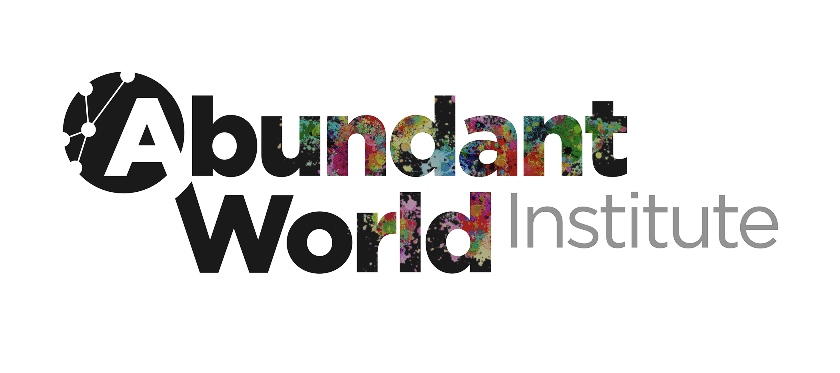About Us
Comprising a society of the world’s foremost technologists, futurists, and entrepreneurs, Abundant World Institute™ is a social enterprise dedicated to identifying and defining exponential solutions to global grand challenges in four key areas of tremendous human consequence: energy, healthcare, education, and food systems. Enabled by a sophisticated innovation platform, we imagineer a better future by connecting the dots looking forward.

What If?
While technology-enabled, the feedstock of our work is decidedly human-driven. That is, we begin by asking very different kinds of questions—better questions—that look beyond the incremental evolution of existing answers to imagine completely new, exponential answers to questions not previously asked.
Not merely a policy thinktank, issues advocate, or consultancy, Abundant World Institute is working alongside other futurist organizations and thought leaders to actualize a better future for all. To these ends, we are defining executable innovations that, while previously unimagined, have the potential to fundamentally and positively alter the trajectories of how humanity lives and thrives in an otherwise anxious, uncertain, and seemingly chaotic world.
Our Process
By virtue of our novel approach and innovative techniques, we greatly expand the capacity for processing cognitive complexity, enabling the discovery of non-intuitive relationships between very different fields of knowledge—biology, psychology, physiology, economics, neurology, mechanics, electronics, materials, physics, and other sciences, technologies, and disciplines—to yield surprisingly creative insights, possibilities, and solutions to very specific global challenges.
Our cross-discipline/cross-pollination methodology is essential, because we know that creative innovation comes from connecting disparate and nonobvious dots—both existing and emerging; it doesn’t take place so much within disciplines as it does at the intersections and boundaries between them. Because these processes are inherently associative, we take in wide-ranging research sources that we algorithmically associate to synthesize entirely new ideas. Whether one calls it computational creativity or artificial imagination, ours is a simultaneously convergence- and divergence-based approach to discovery that also fosters adaptive flexibility, yielding the ability to surface unusual types of solutions to difficult problems.
Characterized by the merging of percepts, ideas, images, and models in a seemingly incongruous fashion, the ideas and innovations formed in this way are always surprising and unexpected. More importantly, they are effective.
For Example . . .
Consider a few cases in point. There are myriad trends that emerged from the combination of completely disparate technologies—otherwise unconnected dots that originate and evolve independently in relatively isolated application spaces. For example, 3D printing was first demonstrated in 1981, but it didn’t gain traction until it met up with CAD and the open-source movement that was ultimately launched in 1998. Or consider graphics processing units (GPUs), digital cameras, and the Internet of Things, each developing in standalone, application-specific domains spanning gaming consoles to mobile phones to home thermostats. Do you see it yet? Okay, let’s throw in LiDAR, machine learning, an array of sensors, and sophisticated actuators. It’s probably obvious now. The self-driving car would not be possible without all of these technologies—an irreducible complexity—yet none of which foresaw their application in autonomous vehicles at the time they were conceived. This is the kind of future potentiality we work to identify long in advance. And it necessarily requires having our feet in multiple technology camps.

As GPS, GPUs, LiDAR, sensors, and machine learning run their routes and make their blocks, the play unfolds as all the action converges downfield, culminating in the self-driving car—a surprising outcome unforeseen by each of the independently developing technologies that comprise the ultimate solution’s irreducible complexity.
Connecting the Dots Looking Forward
Herein lies a great paradox. Steve Jobs, in his famous Stanford commencement address, said, “Of course it was impossible to connect the dots looking forward when I was in college. But it was very, very clear looking backward 10 years later. Again, you can’t connect the dots looking forward; you can only connect them looking backward. So you have to trust that the dots will somehow connect in your future. You have to trust in something—your gut, destiny, life, karma, whatever. This approach has never let me down, and it has made all the difference in my life.”
With all due respect to Mr. Jobs, this is precisely the outlook we seek to overturn: Abundant World Institute has established as its mission the audacious objective of connecting the dots looking forward.

To this animation of the breakthrough difference enabled by imagination, organic or artificial, we add the all-important time dimension, revealing how disparate technologies—factoring in their respective trajectories over time—can combine to create innovative solutions to otherwise intractable problems, ultimately yielding very different and exciting pictures of the future.
Media
Finally, in our publishing capacity, Abundant World Institute is dedicated to producing media of outstanding quality that support and inspire exponential thinking about global challenges. Our award-winning foundational title, Moonshots—Creating a World of Abundance, won the 2019 Gold Medal by Axiom Business Book Awards, and was recognized by Kirkus Reviews as a “Best Book of 2018.” After Shock, published in 2020, marked the 50-year anniversary of Alvin Toffler’s Future Shock. Our newest periodical, Epicenter, provides strategic vantage point for understanding the forces driving technological change. Through our unique seismic framework, we examine the fault lines, tremors, quakes, and aftershocks reshaping the industry, revealing the deeper connections between science, business, and society. By integrating foresight thinking into our analysis, we empower our readers to anticipate change, make informed decisions, and navigate the emerging contours of our shared future. Epicenter is more than a source of knowledge—it’s a meeting place for technologists, business leaders, policymakers, and curious minds to explore, discuss, and shape the future of technology.
Contact Us
To learn more, support our work, or join our advisory board, please contact Abundant World Institute executive director, John Schroeter, here.
